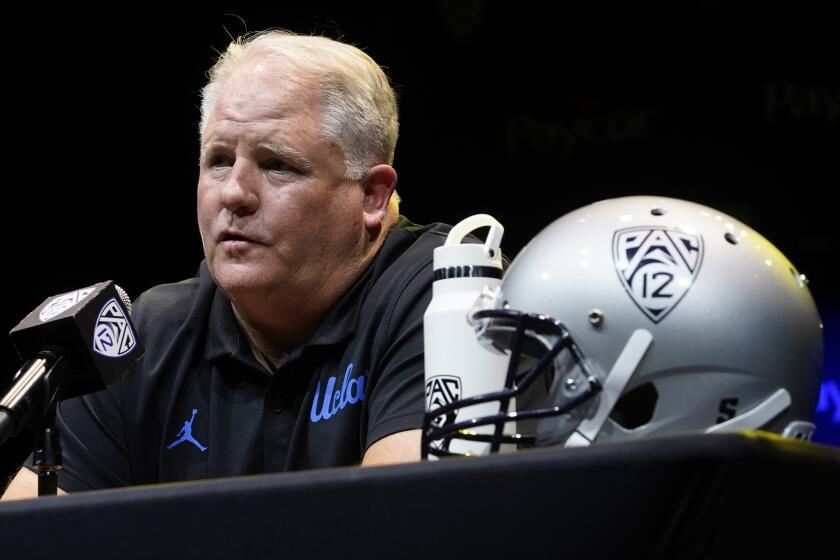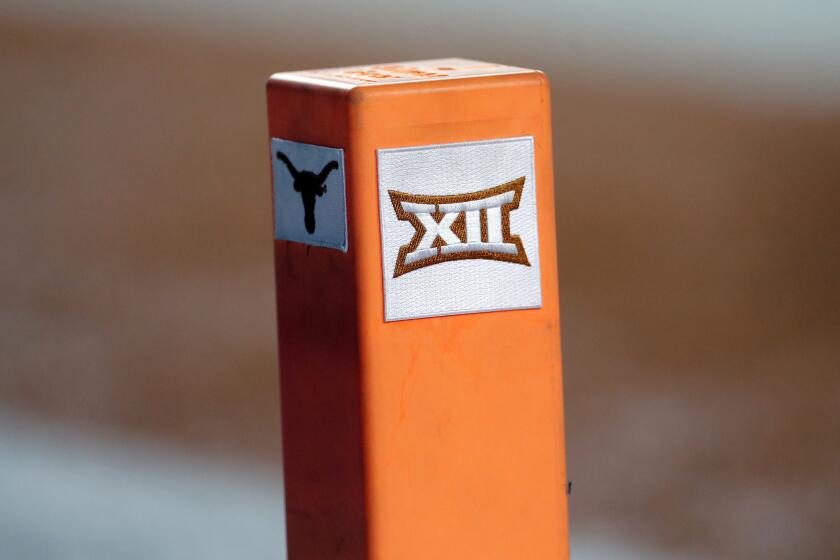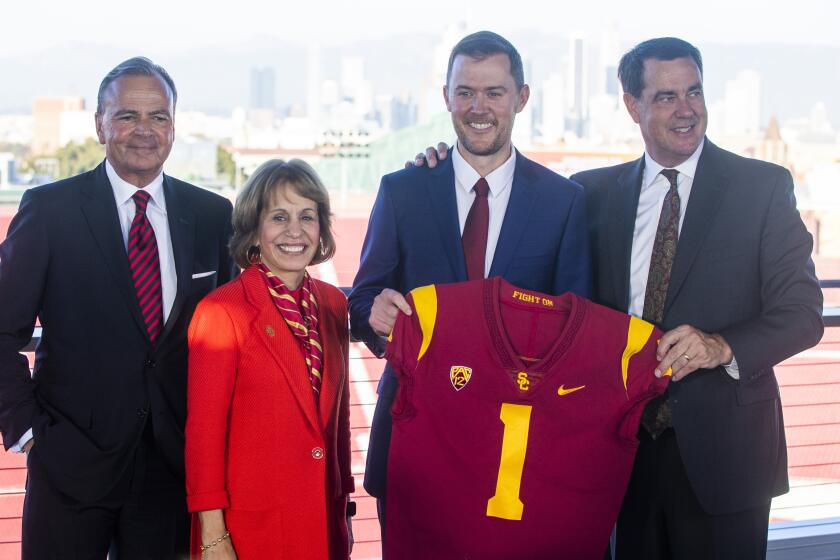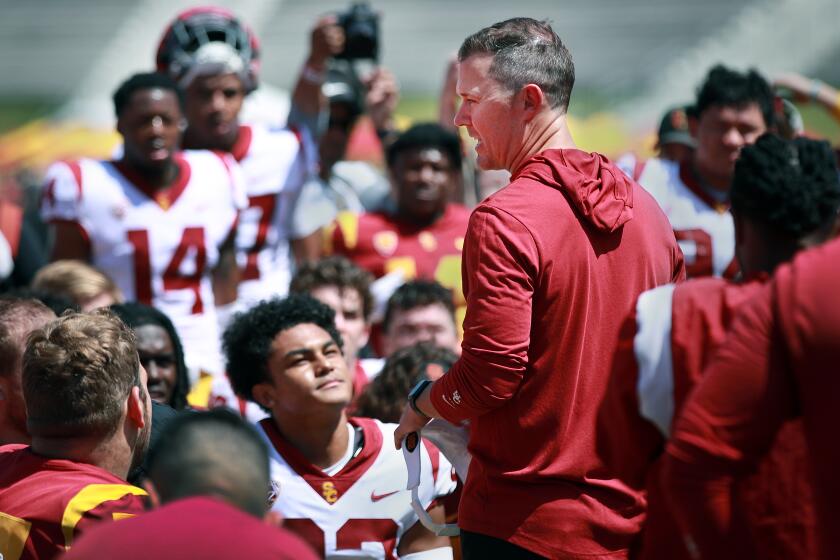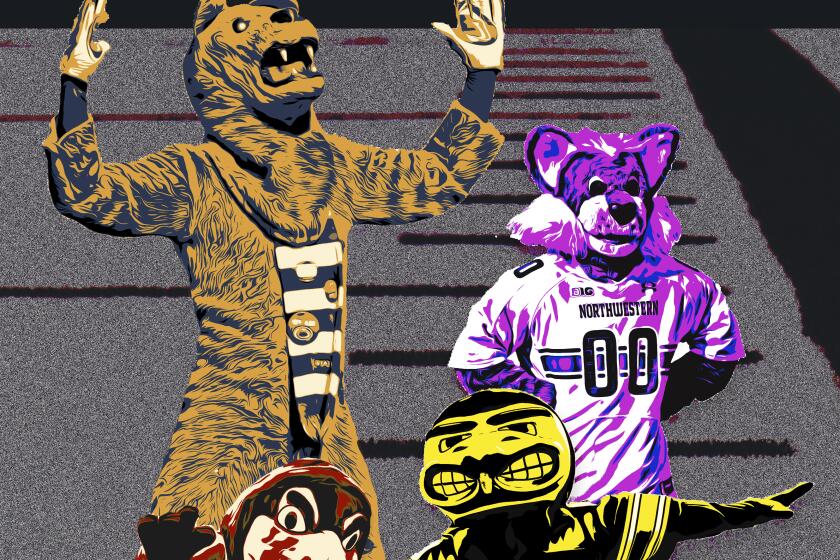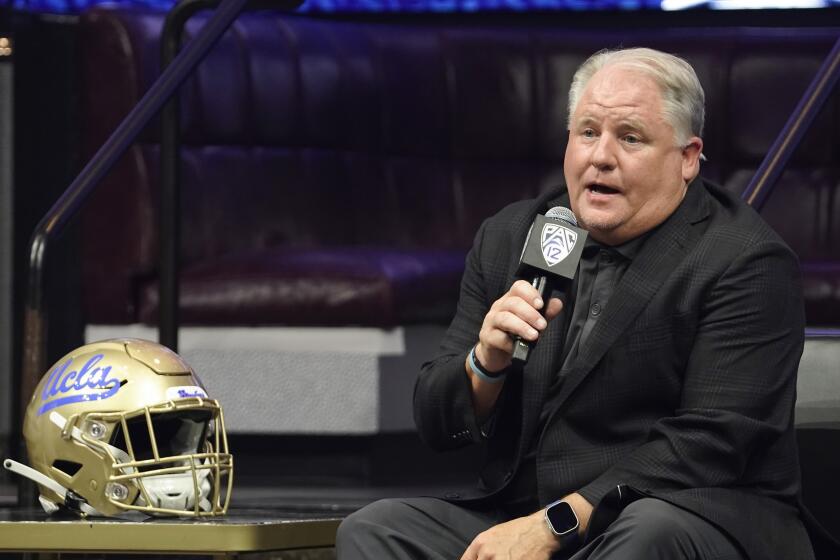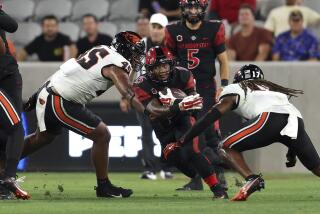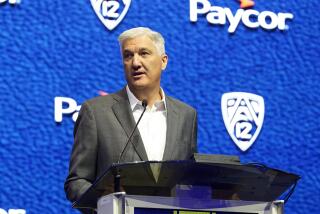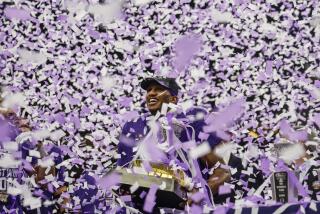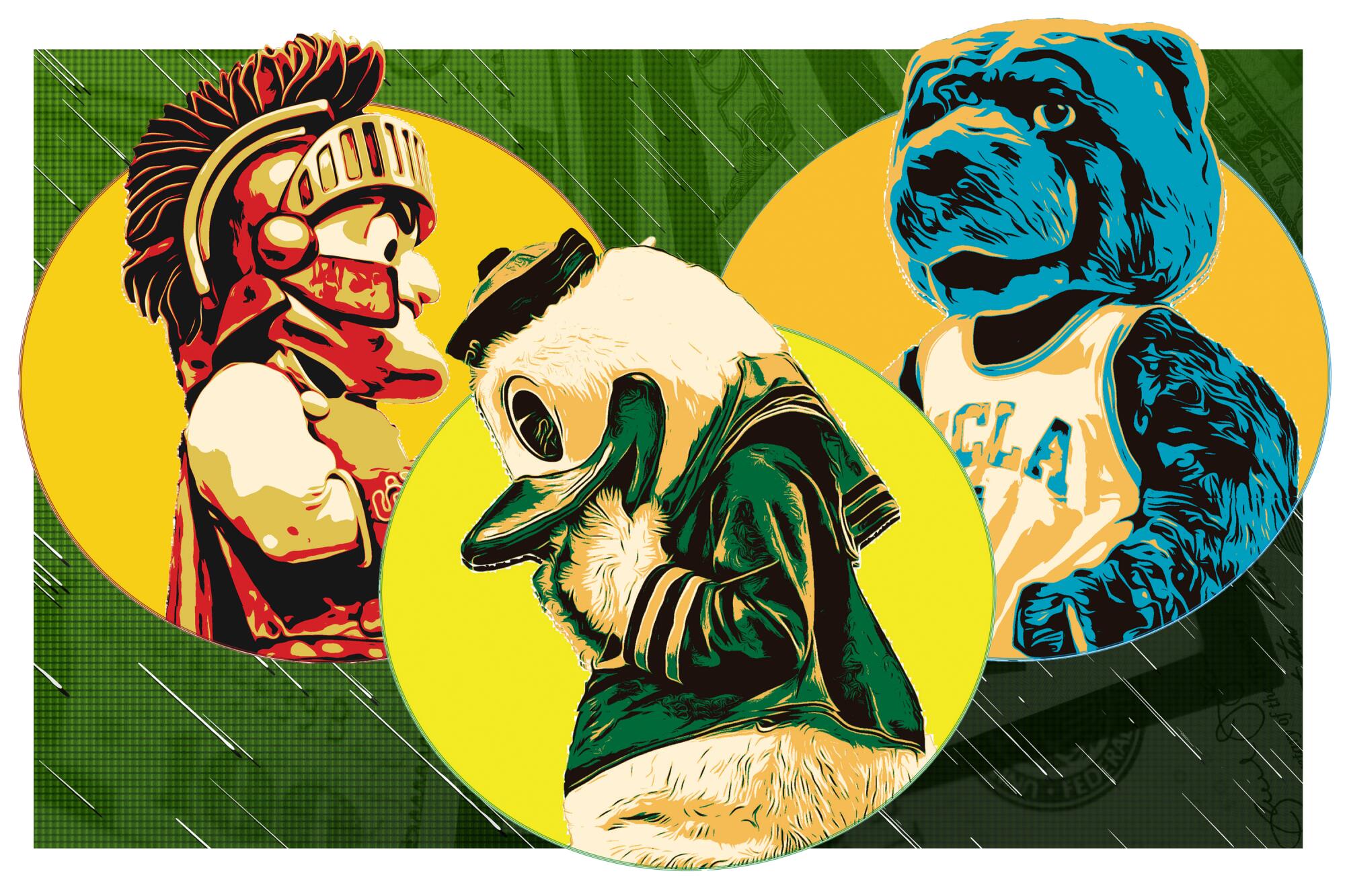
- Share via
As the calendar turned to December 2022, the Pac-12 Conference was in a precarious position.
Six months after USC and UCLA announced they were joining the Big Ten and the Pac-12 began its media rights negotiations early in response, the 10 remaining schools did not have a new TV deal in place. Worse than that, the Big 12 jumped the Pac-12 in line with ESPN and Fox, agreeing in October 2022 to extend its current deal through 2030-31.
But Pac-12 commissioner George Kliavkoff was working on another way to save the 108-year-old conference. Multiple sources not authorized to speak publicly about negotiations shared the following outline of the plan and Pac-12 leaders’ response with The Times.
UCLA’s Chip Kelly came up with an idea to help rescue college football from it’s money-grubbing self, but it’s too logical for the sport’s power brokers.
Publicly, the University of California Board of Regents’ threats to force UCLA to stay in the Pac-12 and avoid hurting UC Berkeley were viewed as posturing, bluffs to get attention and possibly some money from the departing Bruins.
Privately, Kliavkoff was deeply engaged with a small group of regents about the framework of a deal that would lead to the regents voting to block UCLA’s move — even though the regents did not want to set a precedent of overturning a monumental campus-specific decision.
The regents did the math. UCLA was supposed to make $62 million per year from the Big Ten’s new mega media rights deal. The Bruins’ travel costs to compete in the Midwest-based conference were expected to be in the range of $10 million to $12 million annually. So, the regents gave Kliavkoff a magic number. If he could guarantee the Bruins $52 million annually during the five years of the league’s next media deal, the regents promised Kliavkoff a vote heavily in favor of UCLA staying in the Pac-12.
It was not going to be easy for the remaining 10 schools to stomach giving UCLA a much bigger annual revenue share. The Pac-12’s math said that a media rights deal for 11 schools — even with the Los Angeles market back under the conference footprint — was not likely to net $52 million for each school.
Not only did Kliavkoff need the Pac-12 presidents to sign off on the guaranteed money, but they would also have to take the leap of faith to sign a grant of rights binding the schools together without knowing the exact details of what their media deal would be. Lastly, the Pac-12 would have to pay the $15-million fee UCLA would owe to the Big Ten for breaking its agreement.
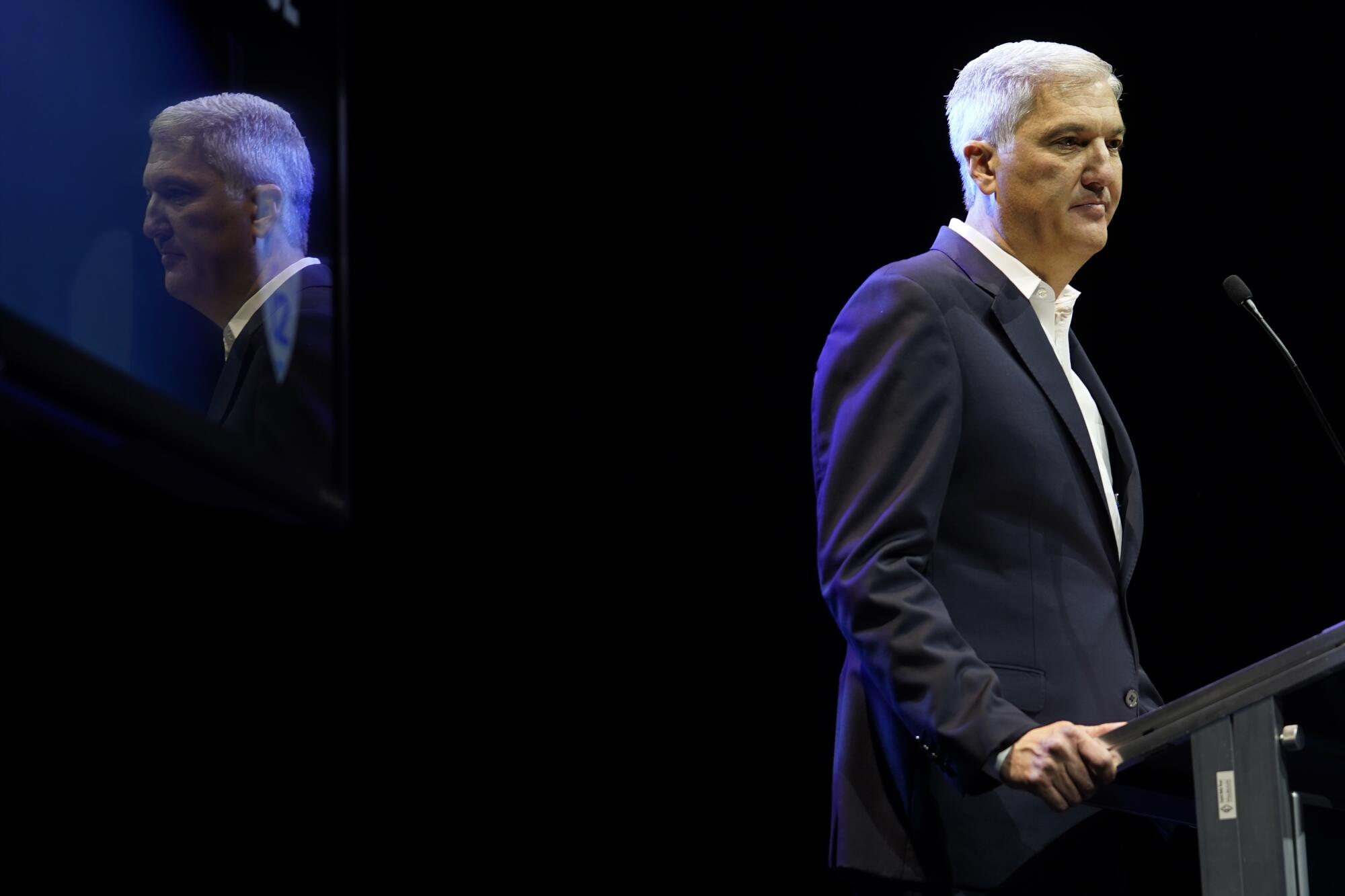
When Kliavkoff presented the idea to the Pac-12 board, Oregon interim president Patrick Phillips vehemently shut it down. He said he would not have the Ducks in a conference where they have to take less money than UCLA, and any conversation about the possibility quickly died.
Kliavkoff declined to comment on the negotiations that played out quietly behind the scenes.
On Dec. 14, the UC Regents met and voted 11 to 5 to approve the Bruins’ exit to the Big Ten. While the vote was assumed by many to be mere formality, it certainly could have gone the other direction — a theme that would emerge time and again on the Pac-12’s road to ruin.
Today, the Pac-12 is now the Pac-4. Oregon and Washington are joining USC and UCLA in the Big Ten, while Colorado, Arizona, Arizona State and Utah are headed to the Big 12. Stanford, Cal, Washington State and Oregon State are left to the whims of an industry that has become comfortable making momentous long-term decisions while under immense short-term pressure.
Following interviews with dozens of sources within the Pac-12 and in other corners of college athletics during the last two years, this is the story behind the Pac-12’s collapse.
The setup
The Pac-12 hired Kliavkoff in May 2021 to clean up a mess that was the making of his predecessor, Larry Scott, and the conference’s university leaders.
The league struggled in just about every facet other than the number of championships won in the lower-revenue Olympic sports. This allowed Scott to constantly trumpet the Pac-12 as the “Conference of Champions” while it fell drastically behind its peers in the Big Ten and SEC in media rights distribution dollars and its self-created Pac-12 Network wallowed in relative obscurity.
The league was not winning in football, the most visible and lucrative sport, either. USC was struggling to recover from crippling NCAA sanctions, and Pac-12 teams had made the new four-team College Football Playoff just twice.
Former commissioner Larry Scott’s media and TV deals couldn’t reach the success of rival conferences, depriving the Pac-12 of millions in revenue.
Morale was down among Pac-12 athletic directors, who felt Scott was disconnected from campus realities, spending most of his time at the conference’s headquarters in downtown San Francisco.
Morale wouldn’t have been an issue if Scott had backed up his promise to make the schools rich. He maintained until his last days leading the league that it was well-positioned to reach revenue goals in its next media rights agreement, but he would not be the one to see it through.
Kliavkoff was an entertainment executive at MGM Resorts in Las Vegas when he landed the Pac-12 job, but he previously worked at Major League Baseball and NBC Universal around the advent of streaming. At NBC, he was part of Hulu’s start. With that experience, it was reasonable for Pac-12 presidents to think he would be equipped to handle their media rights negotiations.
At the time he was hired, though, his most pressing task was mending campus relationships by showing schools that the league office cared about their various plights.
Kliavkoff’s plan was to spend his first weeks on the job as Kumbaya George, visiting each school and taking meetings with all stakeholders, understanding old grievances so he could help break them down.
But three weeks into his tenure, the college sports landscape shook from an unforeseen blast — Texas and Oklahoma were leaving the Big 12 for the SEC.
SEC university presidents voted to invite Texas and Oklahoma to join the league and create a 16-team powerhouse.
Kliavkoff established a war room devoted to making sure his schools would be safe amid the uncertainty. He told The Times in July 2021 that he thrived on solving complex puzzles and that navigating college sports’ next realignment wave was a welcome challenge.
But Kliavkoff couldn’t just go out and unilaterally fight for the Pac-12. His marching orders came from 12 university presidents and chancellors who, in the heat of battle, were about to show they were allies in name only.
To expand or not
Without Texas and Oklahoma, the eight schools left in the Big 12 were looking for a new home. Kliavkoff received word from Big 12 commissioner Bob Bowlsby that the eight were interested in coming to the Pac-12 to make a Pac-20, playing games across every time zone. The Power Five conferences would become a Power Four.
Three sources with direct knowledge of the talks who were not authorized to discuss the negotiations publicly provided The Times with the following new details about the Big 12’s offer and the Pac-12’s response.
Kliavkoff was open to adding all eight, but the league was probably going to be more selective and look seriously at a few schools located in strategic markets.
The Pac-12 formed a membership subcommittee of six officials — three presidents and three athletic directors, each representing one of the league’s six travel pairings. USC president Carol Folt was chosen to represent the Trojans and Bruins.
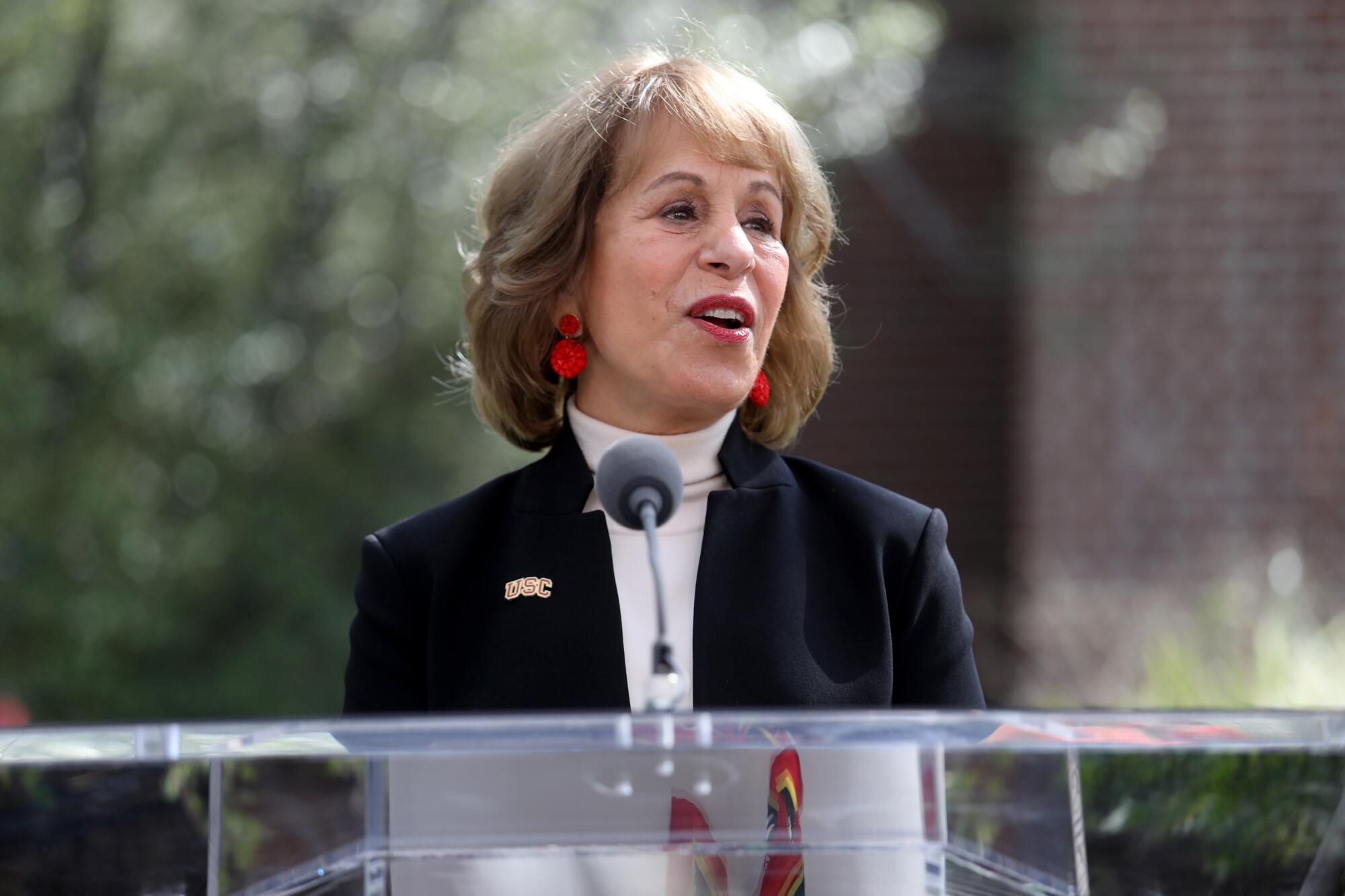
Pac-12 officials prepared a 12-slide presentation deck explaining the merits of expansion leading into the first subcommittee meeting. About three slides in, Folt told the group that she did not understand why the Pac-12 would expand and expressed surprise they were even talking about it.
The Times first reported last year that Folt objected to adding Big 12 teams, citing multiple sources not authorized to speak publicly about the committee’s discussions. It’s unclear whether Folt knew about Big Ten expansion plans involving USC at the time.
“We’re not going to respond to anonymous comments or hearsay,” Folt said in a statement to The Times when asked about the meeting.
Out of deference to the Trojans, whom members of the committee considered the linchpin to a strong future, the discussion ended.
“A lot of times, the way presidents’ rooms work, he or she who speaks the loudest and first kind of sets the dynamic,” a source with knowledge of the discussions recently told The Times. “And if there’s nobody else that has a real strong knowledge base or inclination to do something else, they say the person who has a real strong opinion must feel strongly for a reason.”
During a call with Pac-12 university presidents and athletic directors last year, USC President Carol Folt ‘shut down’ potential expansion plans.
Kliavkoff, in his first weeks on the job, didn’t push back against Folt given USC’s importance to the league, a source said.
Kliavkoff declined to comment on the meeting.
Less than a year later, on June 30, 2022, the Pac-12 was caught off guard when USC and UCLA bolted for the Big Ten.
If the Pac-12 had added Big 12 schools when it had the chance, it would have remained the fourth-best conference without the L.A. schools.
Instead, the Big 12 survived and added four schools of its own from the “Group of Five” — BYU, Cincinnati, Houston and the University of Central Florida. The Big 12 was composed of 12 schools that were not of interest to the Big Ten and SEC, so they presented a united front.
The Pac-12 now featured 10 teams, with Oregon and Washington pining for a Big Ten invite. The timing of the events made the league even more vulnerable. With their media rights agreements complete in the spring of 2024, Pac-12 schools were free to leave and start play in another conference in 2024 with no exit fees.
This time, a war room wouldn’t be enough for Kliavkoff. His wounded conference needed a MASH unit, too.
Dreaming too big
In October 2022, the Pac-12 completed its three-month exclusive negotiating window with Fox without a deal. The network, the Big Ten’s top media rights partner, was viewed as a catalyst in USC and UCLA’s move that bolstered its investment in the Big Ten Network and had little interest in bidding on the 10-team Pac-12’s media rights. But ESPN, which had enjoyed the “Pac-12 After Dark” games that kicked off in the 10 p.m. hour Eastern time, remained very interested, three sources told The Times.
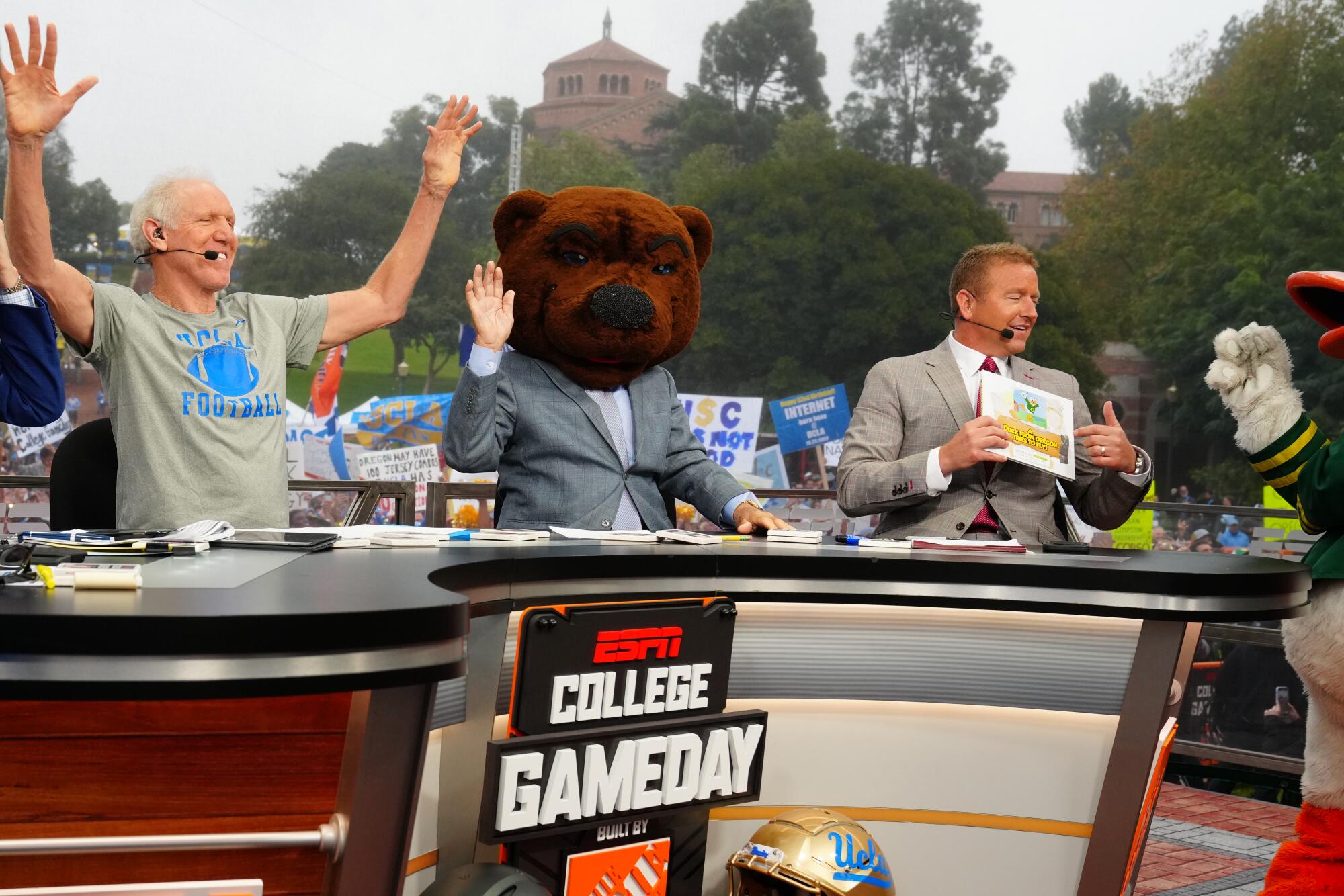
Kliavkoff brought the schools an ESPN offer of $30 million per school annually for all of their rights. The Pac-12’s analysis said the schools would be worth somewhere in the mid-$30-million range apiece, so they could go back to ESPN with a reasonable counter in the high $30-million-range and maybe the two sides would end up around $35 million.
When the Pac-12 CEO group met to discuss the offer, one of the league presidents had other ideas. The president worked with a professor on his campus to come up with their own estimate of what the 10 schools should get based on their market value: $50 million.
“George and our media consultant were pretty clear there was some risk, but they said, ‘Nope, our numbers show we’re worth this, go ask for it,’” a source with direct knowledge of the negotiations not authorized to speak publicly about them told The Times. “... ESPN did not react very well to it.”
Given the stakes of negotiations, a source with experience negotiating media rights agreements told The Times, Kliavkoff should have been more forceful pushing back against the high counteroffer.
Multiple sources declined to provide further details about the university president because discretion is demanded in the industry, especially when details of discussions could deeply damage a person’s reputation.
USC football is the preseason favorite to win the Pac-12 in the conference preseason poll released Thursday.
With the hopes of a potential Big Ten invite out there for Oregon and Washington, it was always going to be hard to persuade them to sign a grant of rights for what amounted to half a Big Ten distribution share. What if the Big Ten later decided to add them at full shares like USC and UCLA? There was no reason for the Ducks and Huskies, in particular, to box themselves in.
To the east, the rejuvenated Big 12 was much more willing to band together at a rate dictated by the networks. On Oct. 30, the Big 12 announced it had re-upped early with Fox and ESPN with a deal that would pay its schools $31.7 million annually.
New Big 12 commissioner Brett Yormark was able to convince his schools that stability was more important than fighting for every last dime.
As part of the Big 12’s deal, Yormark got the networks to agree that if he were to add “Power Five” schools in expansion, the networks would pay for the additions at the same annual rate.
The Pac-12 schools now had no exit fee and an attractive fallback plan in case the 10 couldn’t come to an agreement.
No more waiting
By the time 2023 hit, Kliavkoff was running out of moves. The Pac-12 presidents had nixed expansion, misread the ESPN negotiation and blocked a deal that could have returned UCLA to the Pac-12, albeit with a steep price tag and some kicking and screaming.
He waited out the economic downturn and hoped he could secure a palatable media rights deal.
Pac-12 officials knew that Colorado, in particular, had been flirting with the Big 12. The Buffaloes had been a national power in the Big Eight in the 1980s and 1990s and again emerged in the Big 12 in the early 2000s. As a Pac-12 member, however, they had been a South Division doormat. New football coach Deion Sanders and some influential donors were pushing for a move to the Big 12, a source told The Times.
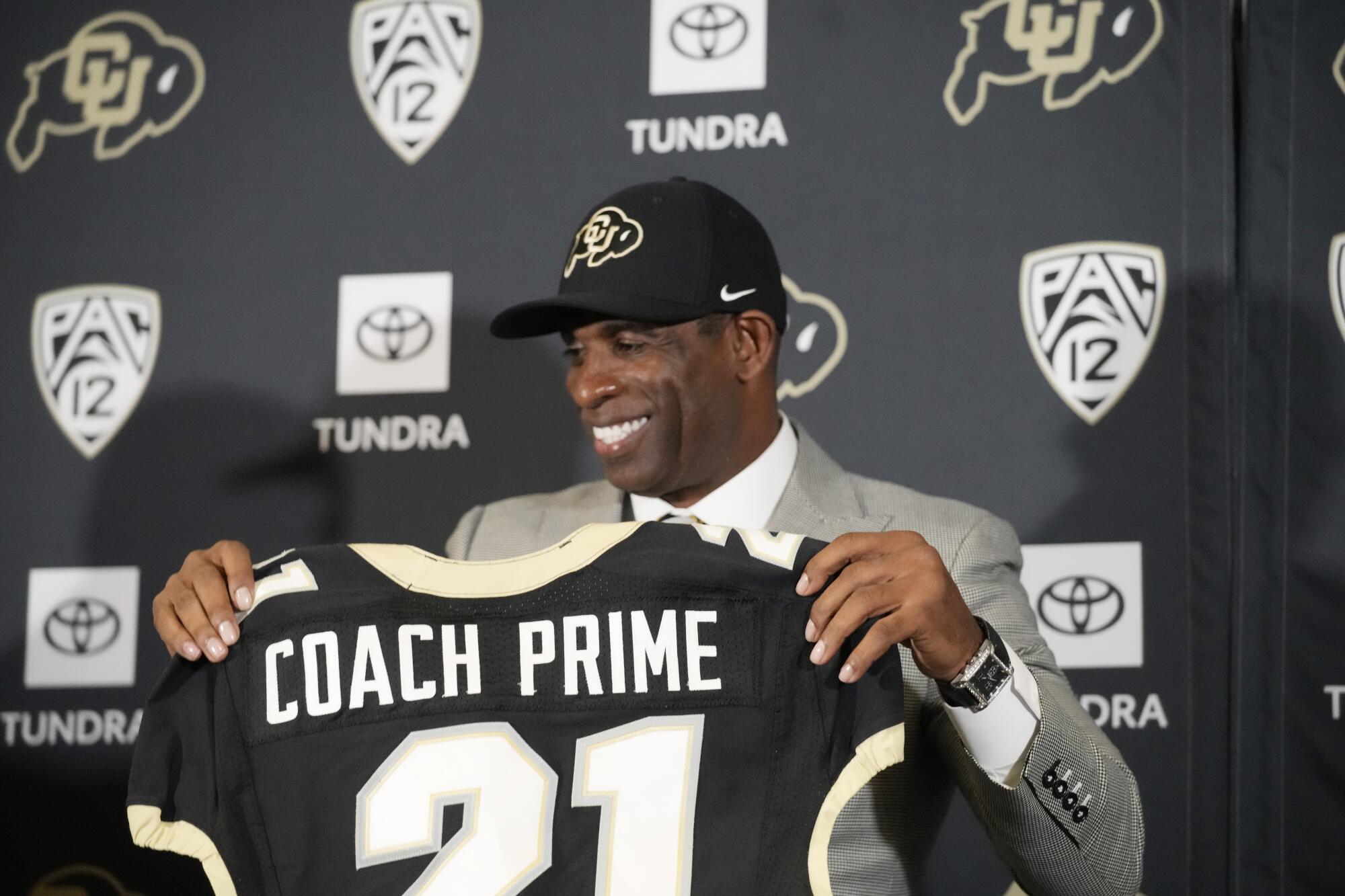
Other Pac-12 schools certainly knew the Big 12 door was open to them as well.
The presidents and chancellors gave Kliavkoff a deadline of July 31 to present final media rights offers.
The commissioner had two options. One was a package based on traditional linear TV distribution that had ESPN taking the top tier of content. NBC and Amazon were negotiating for the second tier, with Fox grabbing the third and CBS the lowest, which amounted to a handful of basketball games.
The second option was an all-streaming deal with Apple, which was excited to add the Pac-12 to its growing sports subscription offerings.
But on July 26, five days before the deadline, Colorado informed the Pac-12 that it wasn’t going to wait any longer. The Buffs were heading back to the Big 12.
“I applaud our [athletic director] Rick George for choosing the best scenario for all athletics at CU,” Sanders told 247Sports.com’s Carl Reed. “This move is a game-changer and we plan on changing the game.”
Soon, negotiations broke down with NBC and Amazon. The linear package was dead.
On Aug. 1, Kliavkoff met with the remaining presidents and chancellors, finally handing them the offer from Apple. Somehow, he was going to have to convince a group of presidents who loved the idea they were worth $50 million to consider an offer for … $23 million.
The final hours
The Apple deal was easy to mock once the number was leaked to the public. It didn’t matter that the deal included additional revenue based on subscriptions that could have put the payout to schools well above the Big 12 and the ACC, or that Apple believed so much in its ability to sell subscriptions to the Pac-12 content that it offered the schools an out after two years if they hadn’t reached the Big 12’s $31.7 million, two sources with direct knowledge of the offer told The Times.
The perception was that the deal was a failure far beyond the small annual distribution.
The offer did not guarantee teams any games on linear TV networks, although that was something that would have been under consideration.
In exactly one year, USC and UCLA will leave the Pac-12 and join the Big Ten. The schools have embraced detailed game plans to help them thrive.
Pac-12 football coaches were going to recruit kids without being able to tell them they would get to showcase their talent on the networks they grew up watching?
With the league clearly in crisis mode, the Big Ten began engaging again with Oregon and Washington, while the Big 12 was circling the Arizona schools and Utah.
Oregon and Washington were the key to keeping the league together, and the Apple deal had one very important Duck feather in its cap.
“Phil Knight loved it,” a source said.
The Nike CEO whose millions helped build upstart Oregon into a West Coast power saw the potential that Kliavkoff was pitching.
After two days of reports circulating that the Ducks and Huskies were pushing to leave for the Big Ten, there was a sudden turnabout. Reports from multiple outlets said the Pac-12 presidents were intending to meet on the morning of Aug. 4 to sign their grant of rights with a 10th school to be added later replacing Colorado.
UCLA football coach Chip Kelly suggested completely reorganizing college football into a system that more closely mirrors professional leagues.
Ten minutes before the meeting was to begin, however, Washington informed the Pac-12 that it was leaving for the Big Ten. The possibility of playing no games on the major linear networks was too tough of a sell for Washington football coach Kalen DeBoer, two sources told The Times.
“I give president [Ana Mari] Cauce and [athletic director] Jennifer Cohen a lot of credit, because these are not easy choices,” DeBoer told reporters after the move to the Big Ten was announced, according to the Seattle Times. “But just thinking years down the road, it came to a point where the resources that we need to be able to provide for our student-athletes … going to the Big Ten allowed for a lot of that.”
Once the Huskies left, the Ducks followed. The Arizona, Arizona State and Utah exodus to the Big 12 flowed naturally from there.
Washington and Oregon were charter members of the Pacific Coast Conference in 1916. They left the only home they’d ever known to join a conference based 2,000 miles away — a league that was only going to pay them each about half a share of what other Big Ten schools will get for the life of its current media deal.
What’s next?
Kliavkoff has been drawing up proposals for the four remaining Pac-12 teams — Stanford, Cal, Oregon State and Washington State.
But first he must wait until the ACC reaches what seems to be an inevitable conclusion. Despite Notre Dame’s pleas on behalf of fellow academic powers Stanford and Cal, the conference based in North Carolina desperately trying to compete with its better-funded neighbors in the SEC doesn’t see enough value in adding a West Coast flank.
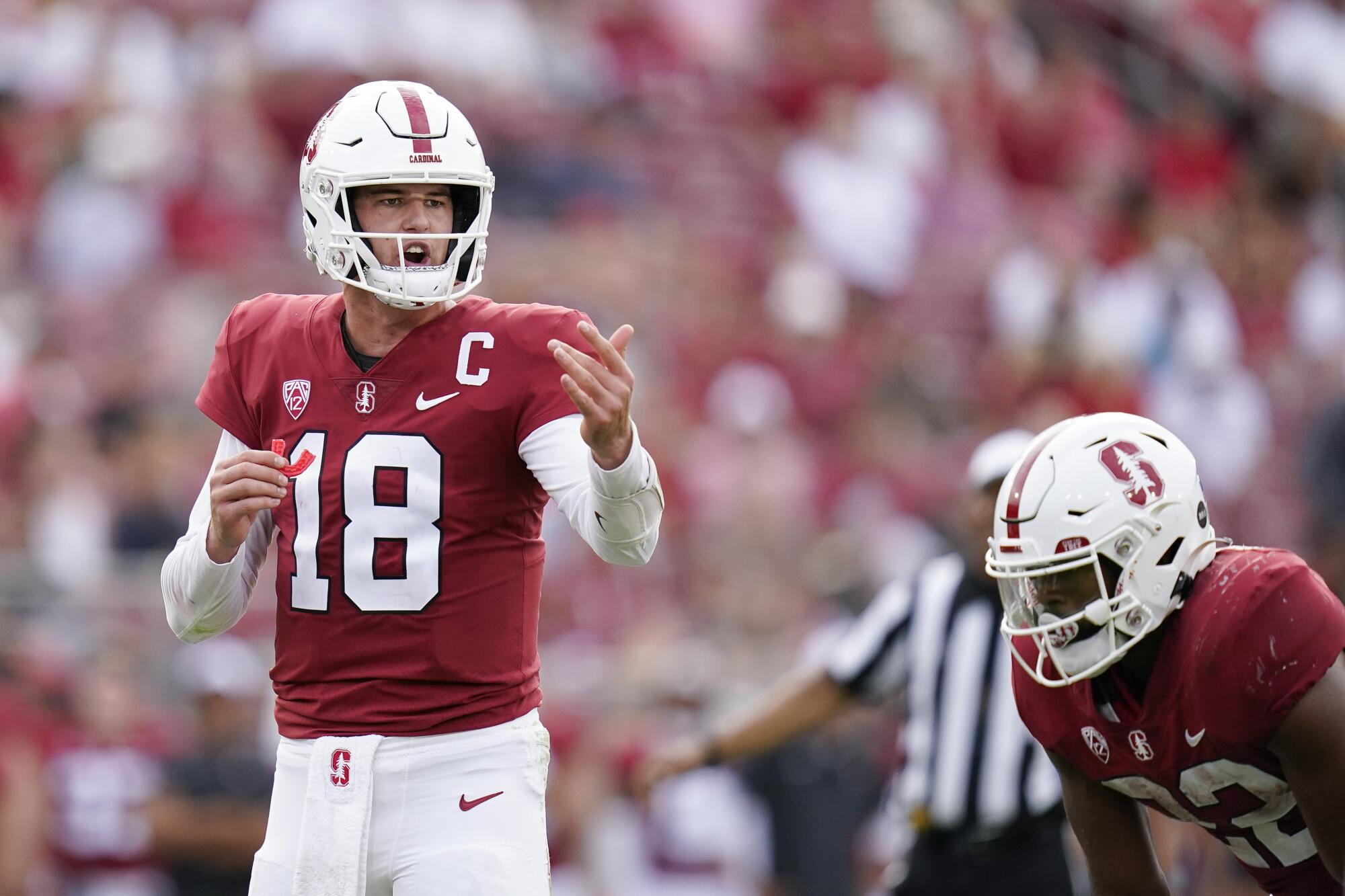
Once the hope of a “power conference” lifeboat with the ACC is officially quashed in the next few weeks, the Pac-4 can work through expansion and merger options with the Mountain West and American Athletic Conference before resuming media rights negotiations.
If the Pac-12 brand makes it through this period of uncertainty as a transformed league, it will have an uphill battle to maintain its status within the College Football Playoff structure as one of the “autonomous five” conferences, which receive a higher share of the financial pie than the group of five schools.
The remaining four have hired consultants to help them clear this crisis, including Washington State hiring Oliver Luck, the former West Virginia athletic director and NCAA executive.
How much of a role Kliavkoff will have in charting the league’s course from this point on remains to be seen.
More to Read
Go beyond the scoreboard
Get the latest on L.A.'s teams in the daily Sports Report newsletter.
You may occasionally receive promotional content from the Los Angeles Times.

